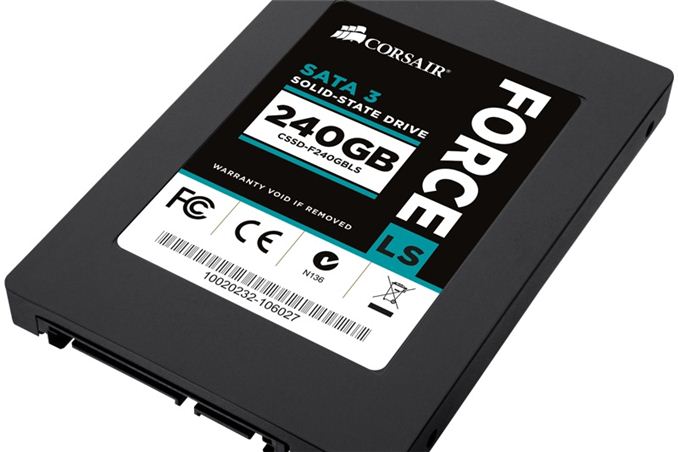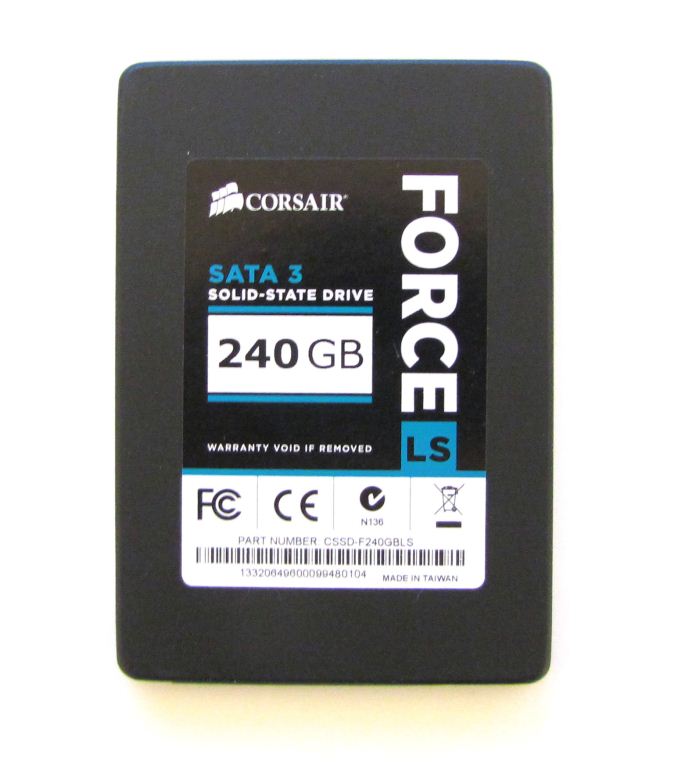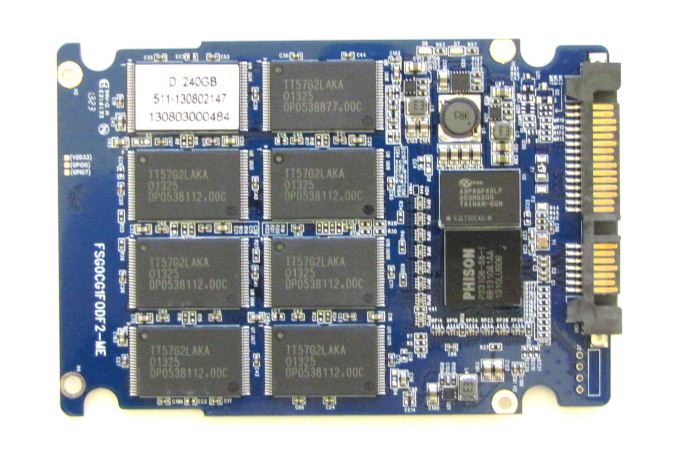Corsair Force LS (240GB) Review
by Kristian Vättö on September 25, 2013 12:00 AM EST
Like many manufacturers without a NAND fab or controller technology, Corsair's SSD portfolio has focused a lot on SandForce based SSDs, but Corsair has been exploring other options as well. Corsair has used controllers from SandForce, Marvell, LAMD and even Indilinx if we go all the way back to SATA 3Gbps times. In other words, that's most of the licensable controllers, although two of them are now out of the licensing game as Indilinx is owned by OCZ and SK Hynix acquired LAMD a while back (technically you can still get a license for LAMD's controllers but SK Hynix forces you to use their NAND).
With fewer controllers available to license, the times for OEMs like Corsair are getting tougher. The SandForce SSD market is still extremely competitive due to the fact that so many OEMs are using SandForce's controllers and the room for differentiation is more or less non-existent. In order to keep their SSD lineup versatile and competitive, Corsair had to look elsewhere for the controller.
The controller manufacturers are not limited to the ones we usually see and there are a handful of options if you're willing to try a not-so-proven solution. As a result Corsair has partnered with Phison for the Force LS. Phison isn't a completely unknown player in the mainstream SSD market as Crucial used their PS3105 controller in their V4 SSD, but that didn't turn out too well. (In short, the V4 was among the slowest SSDs we have ever tested.) MyDigitalSSD has relied heavily on Phison's controllers but again performance isn't particularly compelling. Out of the bigger SSD OEMs, none has given Phison a chance until now.
Phison's big draw is obviously pricing. Licensing SandForce is relatively expensive and there's not much room left for profit margin if you want to price your SSD competitively (which is what you need to do if you want to get sales). Marvell is a more cost efficient option but all you get is the silicon with no firmware or software stack (whereas a SandForce license includes all that). If you have a team of engineers capable of providing a competitive firmware, Marvell can be a good choice; if not, Marvell is not your cup of tea. Phison's business model is similar to SandForce, i.e. they deliver you the whole package, making them a viable option for OEMs without a firmware engineering team. Unfortunately I don't have any specific numbers but I believe Phison's solutions are noticeably cheaper than SandForce's. I don't think Phison's silicon itself is very high power, making it cheap to fab and Phison's controller/firmware as a whole is not as complex as SandForce's, which reduces engineering and validations costs.
| Corsair Force LS Specifications | |||
| Capacities (GB) | 60, 120, 240 | ||
| Controller | Phison PS3108 | ||
| NAND | 19nm Toshiba MLC | ||
| Sequential Read | 560MB/s | ||
| Sequential Write | 535MB/s | ||
| 4KB Random Read | 50K IOPS | ||
| 4KB Random Write | 62K IOPS | ||
| Power (max/idle) | 4.6W / 0.6W | ||
| Warranty | 3 years | ||
Specification wise the Force LS is a close match to MyDigitalSSD's BP4, although that shouldn't come as a surprise since the two share the same hardware. Corsair is offering the Force LS in only three capacities, topping out at 240GB, which is fairly typical for budget SSDs. The controller can support larger capacities (MyDigitalSSD offers a 960GB BP4) but the idea behind offering limited capacities is to steer buyers of higher capacity SSDs towards the more expensive models (like Neutron GTX).
Interestingly, the Force LS will not be available in the US at all. That's unusual since components are rarely region specific unlike e.g. mobile phones where technical and operator limitations come into play. While this is atypical, I can see Corsair's reasoning behind the decision. The US SSD market is way more populated than for example the European market. Most of the smaller manufacturers don't have supply channels in Europe so the market is really dominated by the few big manufacturers that have presence everywhere. With fewer smaller players in the market, I think Corsair saw a niche for a low cost SSD and decided to concentrate on the market where it has the biggest potential.
Internally the Force LS consists of 16 NAND packages (eight per side), which works out to be 16GB per package (i.e. each package has two 8GB dies). There's also 512MB of DRAM from Powerchip Technology (the smaller SKUs have 256MB). The firmware is currently a stock version straight from Phison and my review sample shipped with version 5.8. For comparison, the firmware in MyDigitalSSD's BP4 was 4.3, so I would expect some improvement compared to the BP4.
Test System
| CPU | Intel Core i5-2500K running at 3.3GHz (Turbo and EIST enabled) |
| Motherboard | AsRock Z68 Pro3 |
| Chipset | Intel Z68 |
| Chipset Drivers | Intel 9.1.1.1015 + Intel RST 10.2 |
| Memory | G.Skill RipjawsX DDR3-1600 4 x 8GB (9-9-9-24) |
| Video Card |
XFX AMD Radeon HD 6850 XXX (800MHz core clock; 4.2GHz GDDR5 effective) |
| Video Drivers | AMD Catalyst 10.1 |
| Desktop Resolution | 1920 x 1080 |
| OS | Windows 7 x64 |
Thanks to G.Skill for the RipjawsX 32GB DDR3 DRAM kit












25 Comments
View All Comments
Runamok81 - Wednesday, September 25, 2013 - link
Looks like we have a shrinking middle-class withh SSDs as well. Does this mean manufactuers should focus on one extreme of the performance/value slider or else risk consumers purchasing leftover stock from last years tech?MrSpadge - Wednesday, September 25, 2013 - link
The problem with budget and middle class SSDs is that the bulk of the cost goes into the flash - which you have to buy anyway. The controller does cost a bit, but you can't save much by making an SSD slower. That's why it's not really worth it for customers to spend a little less for a significantly slower SSD. Exception: Samsung 840/840 Evo. they've still got the excellent controller and at least decent performance, yet they mostly cost significantly less than others.ericbentley - Monday, September 30, 2013 - link
Samsung 840/840 Evo can afford to use a good controller yet still be budget oriented because they use TLC flash, while the Corsair LS here still uses MLC. While MLC is better in terms of longevity, most people still want the benefits of speed from the controller and MLC vs TLC is a back-burner issue for themI'm wondering if Corsair had tried TLC before and had some reason for not using it for a drive like this, seems like a no brainer to me, unless they couldn't secure a large enough supply
Kristian Vättö - Wednesday, September 25, 2013 - link
I think we are starting to get to a similar point as where DRAM is now. For an average user, the difference between a low-end and high-end SSDs is becoming negligible because even the low-end SSDs are pretty good now (e.g. the Force LS). That means the middle-class no longer serves a purpose because the average users will mostly go with the cheaper options and enthusiasts only want the fastest.vol7ron - Wednesday, September 25, 2013 - link
The big thing still out there, that hasn't been answered is lots of flash for cheap. When buying an SSD many customers look for the fastest, since the cost is marginal between what's available. However, the one area of the market that is still "expensive" is in the mass-flash +1TB (or even +512GB). Even with a slower controller/NAND, I think Corsair could slide into this space. Look at Apple and what they're shipping their new Mac with - what's it called? Fusion? - essentially a hybrid drive, rebranded. I'm sure a company that focuses on the best balance of quality vs cost, wouldn't do that if SSD costs were lower. --- There's still the niche market for high capacity flash, the ultimate HDD terminator.Spoony - Sunday, September 29, 2013 - link
Apple is shipping a 128GB SSD alongside a normal platter drive in 1TB or 2TB configurations. Fusion Drive is just the name for a logical volume manager with block migration. They are not re-branding a hybrid drive like a Momentus XT. It is a custom solution which merges two discrete devices in software. For better or worse.I definitely agree with you. 1-2TB SSDs at $0.40/MB rather than the current $0.95/MB would be very compelling. I would buy if it was reliable, even if it wasn't blazing fast.
Spoony - Sunday, September 29, 2013 - link
1TB or 3TB configs. Not 2TB. Sorry.Also, edit functionality would be convenient.
Cumulus7 - Wednesday, September 25, 2013 - link
Since you recommend the Samsung EVO over the Crucial M500: aren't yout concerned that the EVO may not last as long as the M500?I prefer the M500 at the moment since i expect its NAND to last a lot longer. But i may be wrong...
fokka - Wednesday, September 25, 2013 - link
of course mlc should theoretically last longer, but that doesn't mean tlc doesn't last more than long enough, as you can read here:http://www.anandtech.com/show/7173/samsung-ssd-840...
MrSpadge - Wednesday, September 25, 2013 - link
I'd choose and recommend the Evo as well, for all typical users. People write much less on average than they fear they might. It's only a different story for power users, servers etc.